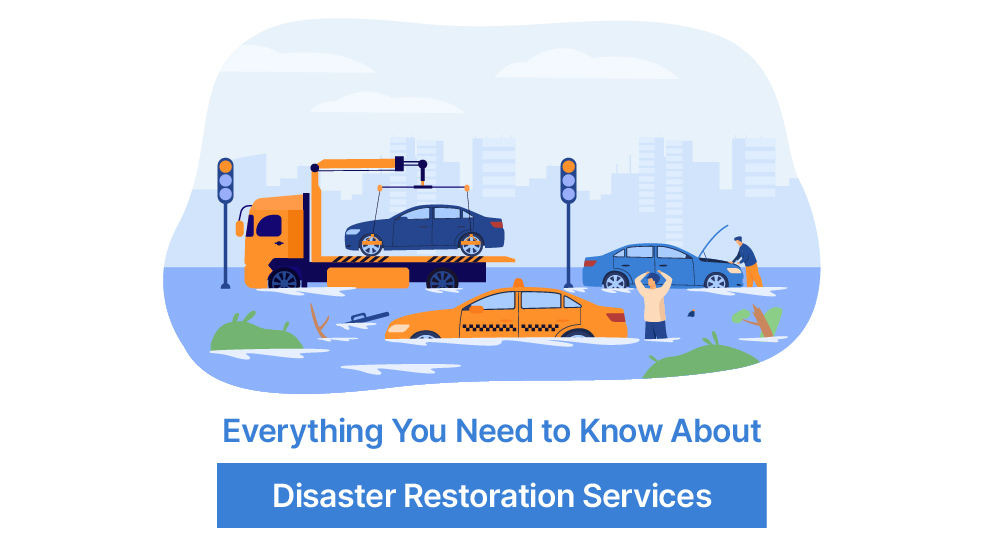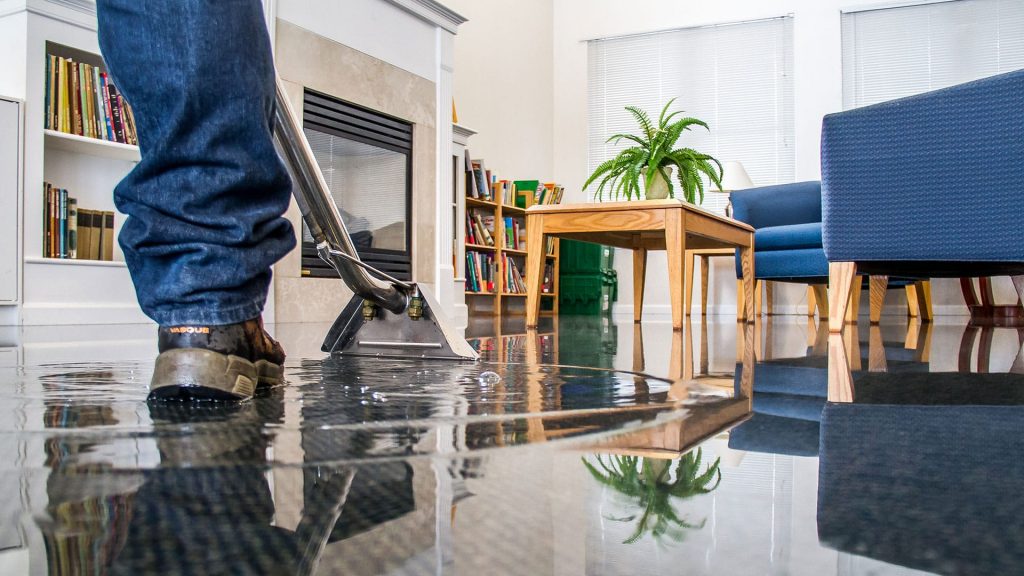Disasters strike unexpectedly, leaving behind a trail of destruction that can turn your living or working space into a chaotic mess. Whether it’s a fire, flood, mold infestation, or any other unfortunate event, the aftermath can be overwhelming. This is where Cleanup & Restoration Services step in, offering a lifeline to restore order and normalcy to your environment.

Understanding Cleanup & Restoration Services
Cleanup & Restoration Services encompass a range of specialized techniques and procedures aimed at recovering and revitalizing spaces affected by disasters. These services play a pivotal role in not only cleaning up the physical debris but also in ensuring the safety and health of occupants. From residential homes to commercial establishments, the need for efficient cleanup and restoration cannot be overstated.
Rapid Response for Swift Recovery
Time is of the essence when it comes to disaster recovery. A swift response from Cleanup & Restoration professionals can make all the difference in minimizing the damage and salvaging belongings. These experts are equipped with the knowledge, tools, and resources to assess the situation quickly and create a comprehensive restoration plan.
The Importance of Rapid Response
The urgency of a rapid response cannot be overstated. Disasters such as fires, floods, storms, and other emergencies can wreak havoc on properties, both residential and commercial. Water can seep into structures, causing structural damage and mold growth; smoke and soot can penetrate surfaces, leaving behind lasting odors and health hazards. In these situations, a timely response becomes critical to prevent further deterioration.
Mitigating Further Damage
One of the primary objectives of rapid response is to mitigate further damage. The longer a property is exposed to post-disaster conditions, the more extensive the damage becomes. Water can lead to structural weakening, corrosion, and mold growth within hours. Smoke and soot residues can discolor and corrode surfaces if left untreated. By acting swiftly, cleanup and restoration professionals can halt these processes and prevent secondary damages.
Salvaging Belongings
Swift action not only protects the structure but also increases the likelihood of salvaging belongings and possessions. Waterlogged documents, cherished personal items, and valuable assets may still be salvageable if attended to promptly. Rapid response teams are equipped with techniques such as document drying, content cleaning, and artifact restoration, ensuring that sentimental and valuable items are given the best chance of recovery.
Health and Safety Concerns
Immediate response is also crucial for addressing health and safety concerns. Water damage can lead to mold growth within 24 to 48 hours, posing health risks to occupants. Smoke residues can release harmful toxins into the air, impacting indoor air quality. By acting swiftly, cleanup teams can minimize health hazards, protecting the well-being of both occupants and restoration professionals.

Components of a Rapid Response
A successful rapid response involves multiple components working in synergy to ensure effective disaster recovery.
1. Preparedness and Planning
Cleanup and restoration companies with a strong emphasis on rapid response have well-established emergency protocols. These protocols involve pre-planning for various disaster scenarios, identifying key contacts, outlining communication strategies, and establishing the necessary resources for quick deployment.
2. 24/7 Availability
Disasters don’t adhere to regular business hours, so neither do rapid response teams. A crucial aspect of rapid response is being available around the clock. Cleanup and restoration companies often have dedicated hotlines or online portals for clients to report emergencies at any time of day or night.
3. Immediate Assessment
Once on-site, the rapid response team assesses the extent of the damage. This assessment informs the creation of a customized restoration plan, outlining the necessary steps to restore the property to its pre-disaster condition.
4. Swift Mobilization
A well-prepared rapid response team can quickly mobilize and deploy to the affected site. This includes bringing the required equipment, tools, and personnel to begin the restoration process immediately.
5. Preventive Measures
To prevent further damage while awaiting full restoration, the team implements preventive measures. These could include setting up tarps to prevent water intrusion, sealing off affected areas to contain contaminants, and initiating drying or dehumidification processes.
6. Collaboration and Coordination
Effective rapid response involves coordination not only within the restoration team but also with other stakeholders such as property owners, insurance providers, and relevant authorities. Clear communication ensures that everyone is on the same page and that the recovery process proceeds smoothly.
7. Efficient Execution
Rapid response teams are trained to work efficiently and effectively. They follow a systematic approach to cleanup, restoration, and recovery, utilizing the latest techniques and technologies to expedite the process without compromising on quality.
Customized Solutions for Every Disaster
Not all disasters are the same, and each requires a unique approach to restoration. Cleanup & Restoration Services tailor their solutions to the specific needs of the situation. Whether it’s water extraction, smoke and odor removal, mold remediation, or structural repairs, their expertise ensures that no aspect is overlooked.
Understanding the Need for Customization
No two disasters are identical, and as such, a one-size-fits-all approach to restoration is inadequate. The extent of damage, the type of materials affected, and the underlying causes of the disaster all contribute to the complexity of the restoration process. Customization ensures that each restoration project is approached with precision, addressing specific issues and optimizing results.

The Impact of Disaster Type
Different disasters have different effects on structures and materials. Water damage may result in structural weakening, mold growth, and material degradation, while fire damage leads to structural instability, smoke damage, and residue-related issues. Mold infestations introduce health hazards and require specialized remediation techniques. Customized solutions take these nuances into account, providing targeted interventions for the best possible outcome.
Considering the Environment
The environment in which a disaster occurs can significantly influence the restoration process. Climate, humidity levels, and geographical factors play a role in determining the methods used for drying, cleaning, and sanitizing. Restoration professionals customize their approaches to accommodate the unique conditions of each location, ensuring the effectiveness of their efforts.
Health and Safety Concerns
Certain disasters, such as those involving hazardous materials, raise specific health and safety concerns. Chemical spills, for instance, demand specialized cleanup techniques to ensure the safety of both the restoration team and the environment. Cleanup and restoration experts evaluate potential risks, implement appropriate safety measures, and develop customized plans that prioritize the well-being of all involved.
The Role of Customized Solutions
Customized solutions in cleanup and restoration services encompass a range of tailored strategies designed to address the specific needs of each disaster scenario.
1. Thorough Assessment
The foundation of a customized solution is a thorough assessment of the damage. Restoration professionals conduct detailed evaluations to understand the scope of the disaster and its effects on different surfaces, materials, and systems. This assessment serves as the basis for developing a comprehensive restoration plan.
2. Tailored Restoration Plan
Based on the assessment, a customized restoration plan is created. This plan outlines the step-by-step approach to restoration, detailing the techniques, equipment, and materials that will be used. It takes into account the specific challenges posed by the disaster and aligns with industry best practices for effective restoration.
3. Targeted Techniques
Customized solutions involve selecting techniques that are best suited to the type of damage incurred. For water damage, this might include water extraction, dehumidification, and structural drying. Fire damage restoration could involve soot and odor removal, structural reinforcement, and content cleaning. Restoration professionals adapt their methods to achieve optimal results.
4. Material-Specific Treatments
Different materials react differently to disasters. Wood, fabric, metal, and electronics each require distinct treatments to ensure effective restoration. Customized solutions consider the unique characteristics of various materials and employ appropriate methods to minimize damage and maximize recovery.
5. Long-Term Considerations
Customization isn’t just about immediate restoration; it also considers long-term implications. Professionals take measures to prevent future issues arising from the disaster, such as implementing strategies to prevent mold regrowth or structural weakening. This proactive approach ensures that the effects of the disaster are mitigated well into the future.
Ensuring Health and Safety
In the aftermath of a disaster, health and safety hazards are a major concern. Cleanup & Restoration professionals are well-versed in identifying potential risks and taking appropriate measures to mitigate them. They follow industry guidelines and regulations to create a safe environment for both workers and occupants during the restoration process.
Identifying Health Hazards
Disasters can give rise to a variety of health hazards, from exposure to toxic substances and contaminants to the spread of diseases. Understanding and identifying these hazards is the first step in ensuring a safe restoration process.

1. Mold and Airborne Contaminants
Water damage, often resulting from floods or leaks, can create the ideal environment for mold growth. Mold releases spores into the air, which can cause allergic reactions and respiratory issues. Cleanup professionals employ specialized techniques to identify, contain, and safely remove mold-infested materials.
2. Smoke and Soot Particles
Fire-related disasters produce smoke and soot particles that can pose severe health risks if inhaled. These particles can carry toxins that are harmful to the respiratory system. Cleanup teams use protective gear and advanced equipment to address these issues, ensuring the removal of smoke residue and improving indoor air quality.
3. Chemical Contamination
Chemical spills and industrial accidents can introduce hazardous chemicals into the environment. Cleanup experts trained in hazardous materials management take precautions to prevent exposure and safely dispose of harmful substances, minimizing the risk of chemical-related health problems.
The Role of Protective Measures
Cleanup and restoration professionals prioritize health and safety by implementing a range of protective measures that safeguard both occupants and workers.
1. Personal Protective Equipment (PPE)
Restoration teams utilize personal protective equipment, including gloves, masks, goggles, and respirators. PPE serves as a barrier against potential hazards and contaminants, reducing the risk of exposure.
2. Containment and Isolation
In cases where health hazards are present, cleanup teams establish containment areas to prevent the spread of contaminants. This includes sealing off affected areas and using negative air pressure systems to prevent the dispersion of airborne particles.
3. Proper Ventilation
Proper ventilation is essential to maintaining indoor air quality during the restoration process. Restoration professionals ensure that affected areas are adequately ventilated to reduce the concentration of airborne pollutants.
4. Safe Disposal
Hazardous materials and contaminated debris require careful handling and disposal. Cleanup teams follow strict guidelines for waste disposal to prevent environmental contamination and protect public health.
Collaboration with Health Professionals
For complex disaster scenarios with significant health implications, collaboration with health professionals is essential. Cleanup and restoration services often work in conjunction with public health officials, industrial hygienists, and medical experts to ensure that health and safety measures are aligned with best practices and regulations.
Education and Communication
Beyond immediate safety measures, education and communication are essential components of ensuring health and safety during and after disaster recovery.
1. Occupant Education
Occupants may need guidance on safe practices during and after the restoration process. Cleanup professionals provide information on potential hazards, preventive measures, and necessary precautions to minimize health risks.
2. Transparent Communication
Open and transparent communication between restoration professionals, occupants, and stakeholders is crucial. Clear communication helps manage expectations, address concerns, and create a shared understanding of the restoration process and safety protocols.
Restoring More Than Just Structures
Cleanup & Restoration Services go beyond restoring physical structures. They understand the emotional toll that disasters can take on individuals and families. By salvaging cherished belongings and sentimental items, they contribute to the emotional healing process, helping to rebuild lives as well as spaces.
The Role of Compassion and Understanding
Cleanup and restoration professionals recognize the trauma that disaster survivors experience and approach their work with compassion and understanding.

1. Emotional Support
Restoration teams often act as a source of emotional support, providing reassurance and guidance to individuals grappling with the aftermath of a disaster. Their presence offers a lifeline of comfort, knowing that skilled experts are working diligently to restore normalcy.
2. Tailored Solutions
Incorporating emotional considerations into restoration efforts, cleanup professionals tailor their solutions to the unique needs of each individual or family. This can mean prioritizing the restoration of sentimental items or creating a personalized restoration plan that aligns with the emotional journey of the occupants.
3. Clear Communication
Effective communication is vital in supporting emotional recovery. Cleanup professionals communicate transparently about the restoration process, timelines, and any challenges that may arise. This transparency fosters a sense of trust and helps occupants feel informed and involved.
Long-Term Impact
The impact of cleanup and restoration services reaches beyond the immediate recovery phase.
1. Psychological Healing
Restoring sentimental belongings and creating safe spaces contributes to psychological healing. Being surrounded by familiar items and a clean, restored environment can promote a sense of security and well-being.
2. Community Resilience
By efficiently restoring properties and helping individuals regain their footing, cleanup services contribute to community resilience. Communities that recover quickly from disasters are better equipped to support one another and rebuild a sense of unity.
Choosing the Right Cleanup & Restoration Partner
Selecting the right Cleanup & Restoration service provider is crucial for a successful recovery. Look for experienced professionals with a proven track record in handling various types of disasters. Check for certifications and affiliations with industry organizations, as these reflect a commitment to excellence.
Steps in Choosing the Right Partner
1. Research and Shortlisting
Start by researching local cleanup and restoration companies. Create a shortlist of potential partners based on their reputation, experience, and services offered.
2. In-Depth Evaluation
Dig deeper into the shortlisted companies. Look at their portfolios, certifications, and case studies of past projects. Assess their experience in handling disasters similar to yours.
3. Consultation and Assessment
Arrange consultations with the potential partners. Invite them to assess the damage and provide a preliminary restoration plan. This is an opportunity to gauge their expertise, professionalism, and communication skills.
4. Cost and Contracts
Request detailed cost estimates and contracts from the remaining candidates. Ensure that the estimates are transparent and include all potential costs associated with the restoration process.
5. Reputation and References
Reach out to references provided by the companies. Inquire about their experience working with the partner, the quality of the work, and any challenges they encountered.
6. Trust Your Instincts
After thorough research and evaluations, trust your instincts when making the final decision. Choose the partner who not only meets the technical criteria but also aligns with your communication style and overall comfort level.
Conclusion
Disasters can be devastating, but the journey to recovery doesn’t have to be. Cleanup & Restoration Services offer a beacon of hope in the midst of chaos, bringing expertise, compassion, and efficiency to the restoration process. By entrusting your space to these skilled professionals, you’re not just restoring bricks and mortar – you’re reclaiming your sense of normalcy and moving forward with renewed resilience.





















Discussion about this post